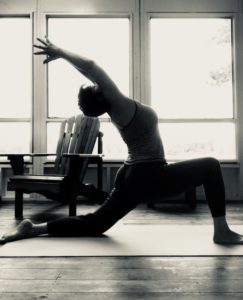“The body is a multilingual being. It speaks through its colour and its temperature, the flush of recognition, the glow of love, the ash of pain, the heat of arousal, the coldness of non-conviction. . . . It speaks through the leaping of the heart, the falling of the spirits, the pit at the centre, and rising hope.” Clarissa Pinkola Estés

Opening the heart to grief, 2018. Photo: Margarita R.
Grief and bereavement is an embodied experience.
When we grieve, we experience not only emotional pain but also physical pain. Sometimes the physical heaviness, tightness or tensions we feel are a manifestation of mourning and grief. Somatic symptoms, such as finding it difficult to sleep, appetite changes, and muscle aches, are widespread in bereaved people.
When we seek relief from the suffering after a meaningful loss in our lives, it is crucial to integrate the body experience. Mind and body are not separate but interconnected. Grief is an emotional and mental experience that is not separate from the body experience.
Grief and bereavement is not a time-limited experience.
This view of grief and bereavement helps us to begin to understand that grief is not a linear process bound by time. Grief is not an experience that we have to get over, move on, or let go.
Grief and bereavement is not a psychological process whose goal is to achieve ‘successful’ mourning, detachment or letting go of the object of our grief. In reality, we often see bereaved people moving back and forth, alternating between periods of focusing on the deceased and maintaining a relationship with them and periods of avoidance and distraction. Other times, people in grief experience periods of having a sense of ‘presence’ of the deceased.
Mindfulness interventions can help us integrate the emotions that inhabit our bodies.
The body is a container where feelings of grief rest and settle and not merely a site of somatic symptoms. Locating wherein our body these emotions take refuge enhances our capacity for self-empathy and self-acceptance. Sometimes grief feels in the body as heavy, constricting or crashing. Other times, it can feel like emptiness, numbness and void.
Guided mindfulness exercises can help us to gently move towards letting feelings of grief express themselves to us. We start to create a narrative of our embodied experience of grief and bereavement. These stories can liberate us of the fixed idea of life and death as separate or divided.
The division between life and death is a humanly constructed boundary borne out by a western culture’s need to segregate, classify and perceive time as linear.
Grief’s initial visceral impact tends to subside when we inhabit and experience our own embodied sense of self. Physical activities, such as walking or incorporating gentle movements, play a part in reconciling our memories, thoughts and feelings with our body and vitality.
“It is amazing how many hints and guides and intuitions for living come to the sensitive person who has ears to hear what his body is saying.” Rollo May

